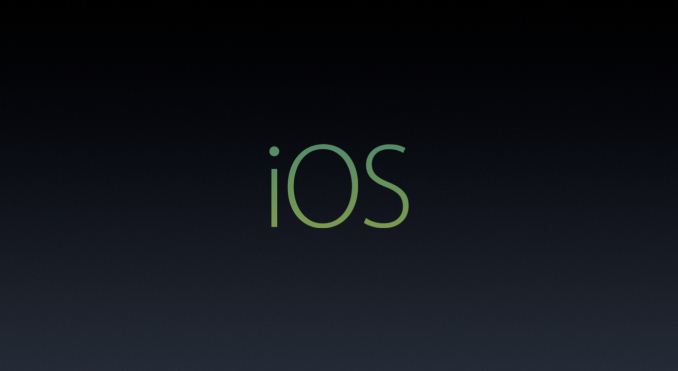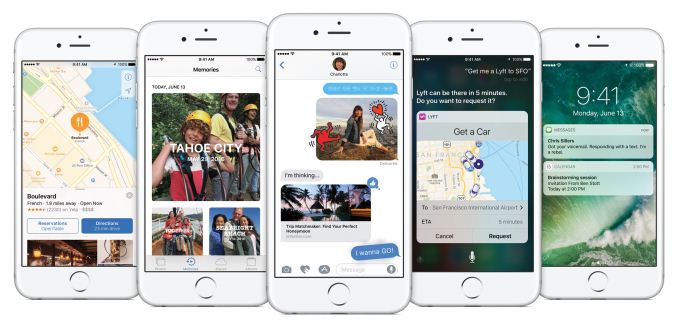The iOS 10 Review: Refining the iOS Experience Both Over & Under the Hood
by Brandon Chester on September 13, 2016 12:00 PM EST
The momentum of the mobile space has changed in the past year. As the market for high end smartphones approaches saturation, the focus on the software side has moved from massive feature expansions to refinement and optimization. We saw great examples of this with both iOS and Android over 2014 and 2015. Whereas iOS 8 and Android Lollipop were heavy with feature releases, iOS 9 and Android Marshmallow were much lighter. Following up to a large feature release provided both teams a good time to reflect upon their development directions and a focus on improving the user experience.
2016 marks a very special year for iOS. After launching as iPhone OS back in 2007, iOS has gone through many iterations and a name change, and has now arrived at version 10. Although version numbers are somewhat arbitrary – Apple has been on macOS 10 for sixteen years now – the tenth major release for an operating system is still an important and exciting milestone. It means that a platform has withstood the test of time, and ideally has had ample opportunity to mature. At the same time however, because it’s a milestone, it’s a reflection on both the past and the future; what has come before, and what is yet to come. For Apple and its eager customer base, iOS 10 embodies this well: the company is in a position where they need to deliver a substantial update, if for no other reason than to satisfy expectations.
With iOS 10 it's difficult to describe what Apple has focused on. It's really one of those OS releases that makes changes to every part of the system. There are big design changes, and big app changes, plus new features and APIs so developers can make even better applications. On top of all that there are performance improvements to bring back the smoothness to areas where it was lost during Apple's rapid redesign and feature boosts in iOS 7 and 8.
With feature-rich releases it can often be difficult to decide where to start the discussion. To keep in line with my previous iOS reviews I'll start off with a look at what changes Apple has made to the iOS UI before moving on to feature changes at the app level and then finishing with changes at the developer level. Without any further delay, lets dive into the new refined design of iOS 10.











113 Comments
View All Comments
ApePriori - Wednesday, September 14, 2016 - link
$399 for a 16GB SE, $549 for a 32GB 6s, $649 for a 32GB 7. More storage and Plus models will bump the price of course, but let's not pretend there are no options unless you spend over $800 dollars.Lavkesh - Wednesday, September 14, 2016 - link
Which is why Samsung isnt Android. They are a memory leak laden software mess.robinthakur - Friday, September 23, 2016 - link
Luckily for Samsung, their phones are just *exploding* in popularity so you probably don't need to worry about upgrading your S7 or Note 7 in 2 years because it will have been recalled.Teknobug - Wednesday, September 14, 2016 - link
Getting an Android through phone carrier causes the longer update times. If you get an Android phone directly from Google or directly from the manufacturer then updates comes pretty quick. Lenovo is the only one that dumped security updates.robinthakur - Friday, September 23, 2016 - link
Yes, it's just a shame that most consumers won't be buying their phones in this way so it's still a massive problem, more from a security perspective, for Android.Lavkesh - Wednesday, September 14, 2016 - link
And the fact that Nexus 5 isnt getting the Nougat update but much inferior hardware Android One devices are! So much so for dont be evil!Xinn3r - Thursday, September 15, 2016 - link
1. Maps also receives some really helpful widgets, including one for transit which allows you to check if there are any service advisories on your favorite transit lines, which has already helped me avoid delays due to subway and streetcar closures that I would not have thought to check for otherwise.I assume this is Google's map instead of Apple? Because I do have that widget for Google Map instead of Apple's own Map.
2. In Notification Center you have a blurred background, and on the lock screen you get the current time and battery charge rather than the date.
In your screenshot of the lock screen, you get current time and date instead of battery charge. I'm also not seeing the battery charge on my lock screen widget.
BulkSlash - Thursday, September 15, 2016 - link
Really awesome review, as an iOS developer it's really great to see a review that focuses on API changes and the benefits they can bring to coders. More of this sort of thing please! :)It would be great to get Xcode on the iPad so I can quickly test out ideas on apps I'm developing if I have a flash of inspiration in the night or something. I definitely see the problems with security though, and also installing things like CocoaPods would be problematic.
I also agree that the way Android handles animations is not good, I'm currently writing an Android app and video animations are currently impossible because the video goes blank during animations! It never does that in iOS!
beggerking@yahoo.com - Thursday, September 15, 2016 - link
nothing interesting or new... Android has had those features/customization for YEARS and Years.and Crapple is still not customizable.
damianrobertjones - Monday, September 19, 2016 - link
Maybe the standard user doesn't care to customize anything!?